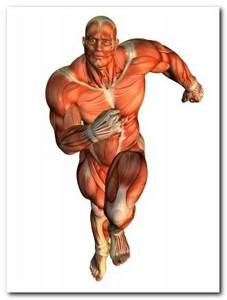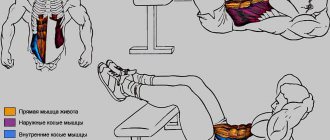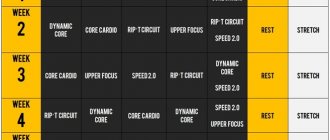What is cardio training?
Aerobic training has a constant pace/speed for a long time
Cardio training is aerobic exercise over a long period of time, during which the muscles use up the body's energy reserves, burning calories.
You can read more about cardio, its types, optimal load and pulse zones in the article about cardio training:
Read the article about cardio training
Proper cardio
Our bodies have an aerobic threshold that determines the type of energy required for physical activity. With low-intensity exercise with a heart rate of up to 150 beats per minute, you burn fat. But once you switch to a high-intensity workout that gets your heart rate above 150 beats (above your aerobic threshold), your body begins to use glycogen from your muscles. This is a faster way for the body to get energy for an intense burst. But for weight loss, such cardio is useless and even harmful. By losing glycogen, we lose muscle volume, fat remains, and the body becomes even more flabby and loose.
Low-intensity cardio is physical activity at a low pace with a heart rate of 120-150 beats per minute. This is exactly the load that uses fat as fuel. At first, these are small reserves of “operative” muscle fat, to restore which the body uses “reserve” subcutaneous fat, which needs to be gotten rid of. Citrate, which is formed during training, blocks the use of glycogen as fuel, so weight loss is faster and more noticeable. And with low-intensity cardio, fat burning processes start after 1 minute.
For low-intensity cardio, the type of workout is not so important. For weight loss, brisk walking, light jogging, an exercise bike, stepper, elliptical, Zumba, dancing, and swimming work equally well. The main thing is to maintain the pulse zone correctly. If there are less than 120 strokes, then the fat will not burn. If it’s more, the muscles will burn.
Options for combining cardio and strength training
When to do cardio: options
As a rule, 85% of people do not have sports goals. They do cardio for health, fun and variety in the training process. However, you need to find the optimal combination so as not to interfere with your progress in strength training.
Cardio can be performed before, after and on a separate day from strength training. We will analyze each option in detail from a scientific and practical point of view.
Cardio training before or after strength training. Weight loss
To perform any physical work, the food a person eats is broken down into proteins, fats and carbohydrates. Proteins are broken down into amino acids, which in turn are used to build the body, grow cells and muscle tissue. Carbohydrates react and, when broken down, turn into pyruvic acid, releasing energy that is spent on doing work. This process is reversible. If the released energy is not used by the body, pyruvic acid is converted into glucose, which is stored in the form of glycogen and fat.
Photo 4. Scheme of the transformation of proteins, fats and carbohydrates into chemical elements.
When there is not enough energy to do the work, some of the fat is broken down, and some is deposited in the subcutaneous layer, surrounds the intestines, and is deposited on the buttocks and thighs. This occurs with the active participation of the hormone insulin, which
- reduces blood glucose levels by converting it into glycogen;
- activates the synthesis of proteins and fats;
- inhibits enzyme activity, preventing the breakdown of fats and glycogen.
In short, insulin is involved in both anabolic and catabolic processes.
A person engaged in physical labor, provided he has a balanced diet, will not gain weight.
When a person is not engaged in heavy physical labor every day, he needs to exercise in order to expend excess energy, giving priority to cardio training - running, aerobics, outdoor games, swimming. To maintain tone and fitness, strength training is also needed, but the ratio of exercises will not be the same as for bodybuilders or athletes. Should you do cardio before or after strength training? To stay in shape, it is recommended to distribute your classes so that between workouts there is enough time for rest and recuperation. It is believed that you can train at any time of the day, because the body adapts to the athlete’s needs. But at lunchtime, the body’s energy output decreases.

Photo 5. A combination of aerobic and strength exercises is used to effectively burn fat.
Cardio before strength training
Cardio before strength training should only be done as a warm-up. 5-7 minutes is enough to prepare the body for the load: during this time, blood flow in the muscles and joints will increase, which will help avoid injuries during training.
You can also perform a set of joint exercises as a warm-up or combine them with cardio. You can read more about this in the article about warming up and get a printable reminder:
Learn how to properly warm up before a workout
If you do a cardio workout before a strength workout, you will simply get tired and will not be able to fully perform a workout with weights. Cardio training will deplete some of the body's energy resources.
If you do not have a goal to gain muscle mass, and you are training to maintain muscle tone, then cardio can be done before strength training. Let's say you went for a run: first you ran 3 km, then you did a set of exercises on horizontal bars and uneven bars. In this case, the combination is allowed.
Therefore, if your goal is to gain muscle mass, then you do not need to do cardio before strength training. In other cases, priority does not matter.
Strength and cardio training on a diet[edit | edit code]
Results of a 2014 meta-analysis by a group of scientists: Eric Helms (ER Helms), Peter Fitscher (Fitschen PJ), Alan Aragon (AA Aragon), John Cronin (Cronin J) and Brad Schoenfeld (BJ). One meta-analysis is about nutrition[1], the second is about training[2].
Briefly about dietary recommendations[3] from the first meta-analysis
- Protein 2.3-3.1 g/kg LBM [4]
- Fats 15-30% of calorie deficit [5][6]
- Carbohydrates according to dietary preference/plan or diet type
- Weekly fat loss (% of body weight) 0.5-1% [7][8]
To achieve the effect of maximizing the preservation of muscle mass on a diet, it is recommended to follow a number of rules.
- Strength training and its anabolic effects can help minimize muscle loss during competition preparation.
- It is more correct to build a training cycle according to the principles of block and wave periodization.
- It is recommended to train each muscle group at least 2 times a week or more often. If each muscle group is trained more than 2 times a week, then it is recommended to distribute the training volume in such a way as to avoid excessive load within one workout (in general, if we train more often, it is better to reduce the volume and distribute it more evenly across all days of the training week).
Below is the recommended training frequency for each muscle group according to Wernbom at al.[9], but I want to make it clear that Wernbom wasn't looking at the issue in terms of caloric deficits, he was looking at protocols for hypertrophy under normal nutritional conditions (well, at least this is not stated separately, but in essence it is logical and presumed), and yes, this data was collected on athletes of different levels of training (from beginners to professional athletes; more than 60 studies), on the type of training, intensity, level of training. Some of this data, among other things, formed the basis for the conclusions of Helms’ team.
- The number of repetitions can vary from low to high (3-15), but should generally be in the range of 6 to 12 repetitions with a weight of 70-80% of 1RM (one repetition maximum).
- For one workout, each muscle group should have a total of about 40-70 repetitions, although experienced athletes can use higher volumes.
- Rest intervals should be the standard 1-3 minutes, although the rest period can be longer.
- The pace of the exercise should be selected in such a way that throughout the entire training movement maximum control is maintained and technique is observed as much as possible: in this case, the concentric phase (lifting weights, muscle contraction) should take about 1-2 seconds, the eccentric (lowering) phase should take about 2 -3 sec.
- Recommendations for failure training: You should limit training to failure when performing multi-joint exercises, but you can use this approach for high-repetition, single-joint exercises.
- The basis of the training should be multi-joint exercises, and also include isolating single-joint exercises as “auxiliary exercises” to load those muscles to which the athlete pays special attention. Moreover, it is recommended to perform multi-joint exercises before single-joint exercises. And it is advisable to train large muscle groups at the beginning, moving on to small ones. But at the same time, one should be guided by the athlete’s goals, and if there are lagging muscle groups, it may make sense to start training by working the lagging muscles (the logic here is simple, if you start working these muscles after performing a series of exercises, then there may not be enough strength left for the lagging ones and their development will be ineffective, which ultimately can lead to even greater loss on the diet).
- The full amplitude of the training movement in ideal technique (or close to it) is recommended.
- Cardio training can be used to optimize the fat burning process. But it is necessary to take into account that increasing the frequency and duration of cardio training negatively affects the results of strength training. Thus, it is recommended not to overdo it with cardio training; you should maintain the frequency and duration of cardio training at the minimum required (for fat burning) level. Based on research, it is optimal to perform cardio on stationary bikes or cardio workouts that involve the whole body (not just the upper or lower body; for example, fullbody with light weights/kettlebells).
High-intensity cardio is not bad if present, but here you need to look at individual characteristics in recovery, i.e. It should be taken into account that this type of cardio requires more recovery time. Fasted cardio does not seem to have any advantage over postprandial exercise and may even have a negative effect, but there is no definitive data on this (fasted cardio, although associated with nitrogen losses, equates to about 14 grams of amino acids per day). 60 min cardio, but there is no data on whether this is a loss of MM, and whether this loss will ultimately be compensated by the intake of protein in the post-workout meal).
Is it possible to do cardio while gaining muscle?
It is commonly believed that cardio training interferes with muscle gain. However, there are studies that prove the opposite. Here is one of them:
1View research
The study involved 102 people (men and women aged 18-40), who were divided into three groups:
- Did cardio before strength training
- Did cardio after strength training
- Did cardio on a separate day from strength training
Over the course of 24 weeks, each group performed the same amount of training load. Let's compare the results:
Graph 1. Lean muscle mass gain
This graph shows that the group that performed cardio training on a separate day from strength training gained more lean muscle mass than the other groups.
Graph 2. Reduction of body fat component
When it comes to fat loss, doing cardio on a separate day from your workout showed the best results. However, cardio is not the main factor in losing weight; calorie deficit plays a primary role.
This study found that doing cardio on a separate day from strength training has benefits for weight loss and lean muscle mass.
It is important to understand that theory trails behind practice. If studies show that cardio does not interfere with strength training, then it is not a fact that in practice this will be the case for an individual person. Individual factors play a huge role here: level of physical fitness, daily routine, whether recovery is sufficient, whether nutrition is adequate. Therefore, the optimal mode can only be selected experimentally.
Option 2 – cardio after strength training
Cardio after strength training - by most people who are interested in fitness, it is considered the best way to lose weight through a combination of two types of activity (aerobic - cardio and anaerobic - strength).
When people ask me questions about whether such and such a method is good or bad, I often answer the question with a question - they say, what are your goals. Since, knowing the goal, you can choose the method that will lead you to it fastest.
– I want to lose weight, lose excess weight, reduce the percentage of body fat! – Do you regulate your diet? - Not yet. - Then let's start with accounting for KBZHU.
And again - if you run after a strength training, thinking that this way you will lose weight faster, since during the strength training you have already exhausted all the glycogen, and during cardio the fat you hate will burn, then this is unlikely to be true.
If after strength training you have enough energy to do intense cardio training, maybe you are not finishing up on strength training? Maybe it makes sense to reconsider the load and train more effectively?
Under no circumstances should you judge the success of strength training by your condition after it.
Nobody says that after a strength training you need to crawl out of the gym, but going out so fresh that you have plenty of energy left to carry out a cardio workout of any duration and intensity is also not an option, would you agree?

The practical conclusion from all this can be drawn as follows: the option of performing cardio after strength training is again more suitable for experienced practitioners who clearly understand that the tasks of strength and cardio training are different.
If a beginner does this, then during strength training there is always a beacon in his mind that he will also have cardio, and this beacon simply will not give him the opportunity to give his best in strength training.
But you also need to take into account that a beginner cannot yet give all his best in strength training, since the “brain-muscle” connection is not so strong yet, it is not possible to use them to the fullest. Therefore, you can often hear from beginners after strength training: “For some reason, I’m not very tired.”
Cardio training in the gym. Cardio training in the gym: what is it, its benefits
Cardio training is a set of physical exercises that raise your heart rate. The most common types of cardio training are running, aerobics, brisk walking and cycling. However, some strength exercises can also be done in cardio mode.

Many people agree that cardio training is equal parts beneficial and boring. Pushing yourself to work out at home is much more difficult than in the gym.
There are too many temptations at home: watch TV, lie down to rest, have a snack, etc. When working out in the gym, these temptations become unavailable, so all that remains is to run kilometers on the treadmill or do hundreds of jumping ropes.
When doing cardio training without additional exercises. loads, the lungs are actively ventilated, the cardiovascular system is trained, the metabolic process improves and, of course, extra pounds are burned.
Important! People with increased body weight who are trying to lose weight are not recommended to actively run. Impact loads have an extremely negative impact on joints, provoking the development of chronic pain. It is better to opt for elliptical walking, an exercise bike, a rowing machine or swimming.
Strength aerobics

This method is a little similar to the previous one, but there are still differences. Here you work at a very intense pace using the principle of circuit training or supersets and trisets. High-tempo workouts and relatively light, high-repetition weights create ideal conditions for burning fat as you work in an aerobic mode, but the added bonus of dumbbells, barbells and machines only speeds up this process. Therefore, it turns out that cardio and strength training are not separated at all, but serve as one whole.
The duration of such a workout should be on average about 1 hour, plus or minus 5-10 minutes for warm-up and stretching.
These were the main points regarding cardio and strength training and the right combination of both. Choose the most comfortable and suitable option for yourself and have fun. And remember that cardio and strength training must be combined; their presence is simply mandatory in your training, the goal of which is fat burning.
And sincerely yours, Skripnik Yanelia, was with you!











